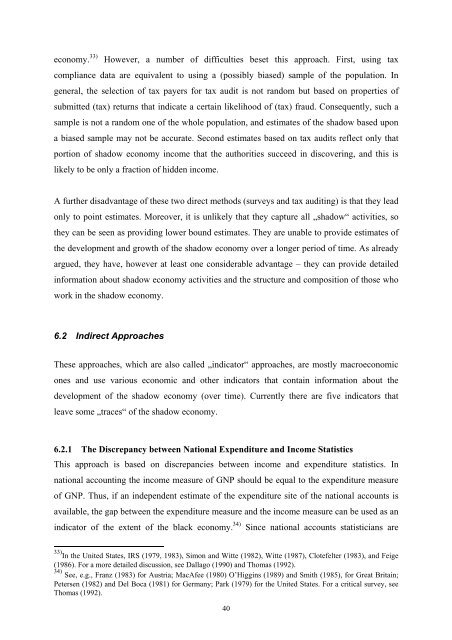Shadow Economies and Corruption All Over the World - Index of - IZA
Shadow Economies and Corruption All Over the World - Index of - IZA
Shadow Economies and Corruption All Over the World - Index of - IZA
You also want an ePaper? Increase the reach of your titles
YUMPU automatically turns print PDFs into web optimized ePapers that Google loves.
economy. 33) However, a number <strong>of</strong> difficulties beset this approach. First, using tax<br />
compliance data are equivalent to using a (possibly biased) sample <strong>of</strong> <strong>the</strong> population. In<br />
general, <strong>the</strong> selection <strong>of</strong> tax payers for tax audit is not r<strong>and</strong>om but based on properties <strong>of</strong><br />
submitted (tax) returns that indicate a certain likelihood <strong>of</strong> (tax) fraud. Consequently, such a<br />
sample is not a r<strong>and</strong>om one <strong>of</strong> <strong>the</strong> whole population, <strong>and</strong> estimates <strong>of</strong> <strong>the</strong> shadow based upon<br />
a biased sample may not be accurate. Second estimates based on tax audits reflect only that<br />
portion <strong>of</strong> shadow economy income that <strong>the</strong> authorities succeed in discovering, <strong>and</strong> this is<br />
likely to be only a fraction <strong>of</strong> hidden income.<br />
A fur<strong>the</strong>r disadvantage <strong>of</strong> <strong>the</strong>se two direct methods (surveys <strong>and</strong> tax auditing) is that <strong>the</strong>y lead<br />
only to point estimates. Moreover, it is unlikely that <strong>the</strong>y capture all „shadow“ activities, so<br />
<strong>the</strong>y can be seen as providing lower bound estimates. They are unable to provide estimates <strong>of</strong><br />
<strong>the</strong> development <strong>and</strong> growth <strong>of</strong> <strong>the</strong> shadow economy over a longer period <strong>of</strong> time. As already<br />
argued, <strong>the</strong>y have, however at least one considerable advantage – <strong>the</strong>y can provide detailed<br />
information about shadow economy activities <strong>and</strong> <strong>the</strong> structure <strong>and</strong> composition <strong>of</strong> those who<br />
work in <strong>the</strong> shadow economy.<br />
6.2 Indirect Approaches<br />
These approaches, which are also called „indicator“ approaches, are mostly macroeconomic<br />
ones <strong>and</strong> use various economic <strong>and</strong> o<strong>the</strong>r indicators that contain information about <strong>the</strong><br />
development <strong>of</strong> <strong>the</strong> shadow economy (over time). Currently <strong>the</strong>re are five indicators that<br />
leave some „traces“ <strong>of</strong> <strong>the</strong> shadow economy.<br />
6.2.1 The Discrepancy between National Expenditure <strong>and</strong> Income Statistics<br />
This approach is based on discrepancies between income <strong>and</strong> expenditure statistics. In<br />
national accounting <strong>the</strong> income measure <strong>of</strong> GNP should be equal to <strong>the</strong> expenditure measure<br />
<strong>of</strong> GNP. Thus, if an independent estimate <strong>of</strong> <strong>the</strong> expenditure site <strong>of</strong> <strong>the</strong> national accounts is<br />
available, <strong>the</strong> gap between <strong>the</strong> expenditure measure <strong>and</strong> <strong>the</strong> income measure can be used as an<br />
indicator <strong>of</strong> <strong>the</strong> extent <strong>of</strong> <strong>the</strong> black economy. 34) Since national accounts statisticians are<br />
33) In <strong>the</strong> United States, IRS (1979, 1983), Simon <strong>and</strong> Witte (1982), Witte (1987), Clotefelter (1983), <strong>and</strong> Feige<br />
(1986). For a more detailed discussion, see Dallago (1990) <strong>and</strong> Thomas (1992).<br />
34) See, e.g., Franz (1983) for Austria; MacAfee (1980) O’Higgins (1989) <strong>and</strong> Smith (1985), for Great Britain;<br />
Petersen (1982) <strong>and</strong> Del Boca (1981) for Germany; Park (1979) for <strong>the</strong> United States. For a critical survey, see<br />
Thomas (1992).<br />
40
















